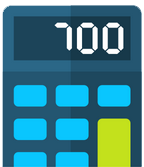Calculate Your Higher Rate Pension Tax Relief
Higher rate taxpayers who pay tax above the basic rate and put money into a workplace pension plan should check if additional tax relief is available.
As an incentive the government gives tax relief on personal pension contributions at the highest rate of tax you pay.
This means if you are a higher rate tax payer you could be entitled to an additional 20% tax relief on your private pension contributions.
Many higher rate taxpayers don’t claim back what they are entitled to and pay too much tax through PAYE.
Importantly the higher rate pension tax relief available has to be claimed by you and will not be applied automatically.
The tax relief applies not to the current tax year but also to the past four years.
Our pension tax relief calculator is designed to help UK taxpayers quickly estimate how much additional tax relief they may be entitled to claim on their pension contributions.
How the pension tax relief calculator works
The calculator assumes your income falls into the higher rate tax bracket which means your highest rate of tax is at 40%.
It calculates what you may be due by working out 20% of the value of your pension contributions for one tax year only.
HMRC allows you to claim back for four previous tax years meaning multiple years refunds are possible at the same time.
A pension tax refund example:
This example uses a total pension contribution of £10,000.
- £10,000 pension contributions
- 20% of £10,000 is £2000
- Total additional higher rate pension tax relief available £2000
Four year higher rate pension tax relief limit
The tax office lets you reclaim overpaid tax for the last four tax years only. If you leave it any later you will normally lose any money you are owed.
Most higher rate tax payers will make private pension contributions for many years meaning the value of the additional 20% tax relief available is substantial.
How do I know if I am a higher rate tax payer?
To find out if you have paid tax at the higher rate you will need to know which taxable band your income fits into.
Being a higher rate tax payer means you pay tax at 40% or more. The taxable bands can change each tax year so it’s best to check if you are unsure.
Higher rate pension tax relief taxable bands
The current income tax bands and rates for England, Wales & Northern Ireland are:
- Personal allowance: £0 to £12,570 @ 0% tax rate.
- Basic rate: £12,571 to £50,270 @ 20% tax rate.
- Higher rate: £50,271 to £125,140 @ 40% tax rate.
- Additional rate: Over £125,140 @ 45% tax rate.
Be aware that the government can change income tax rates and bands quite regularily so it’s best to check if there has been any amendments before claiming.
Different tax rates usually apply in Scotland which can affect the value of claims for Scottish taxpayers.
How to claim your higher rate pension tax relief
How you claim your pension tax rebate depends on your own set of circumstances.
Information from the pension provider confirming the type of pension scheme and payments made in each tax year is normally needed as evidence.
Under PAYE, you must submit your claim within four tax years or forfeit your entitlement.
For claims relating to past tax years, you’ll need to contact HMRC directly:
- You can utilise HMRC’s online dedicated portal for higher rate pension relief claims through the .GOV website.
- Alternatively, you may submit a written application with supporting documentation for each tax year to:
PAYE and Self Assessment,
HMRC,
BX9 1AS.
Higher rate pension tax relief through Self Assessment
If you complete a self assessment tax return you need to include your private pension contributions in your tax return.
There is a designated section in your SA100 tax return to include your annual private pension contributions found under the specific section called ‘Tax reliefs’.
You can amend any tax returns that have been submitted in the past which didn’t include your private pension contributions.
This process is called an overpayment relief claim and must be made within strict timescales to allow for any refund of tax due to be issued.
Take a look at our Pension Tax Relief Guide to find out more about pensions and the tax relief that higher rate taxpayers can claim.
What about additional rate taxpayers?
The same pension tax relief rules apply to individuals paying additional rate tax at 45%.
HMRC gives tax relief at 25% (the difference between basic rate and additional rate) instead of 20% for additional rate taxpayers.
How does HMRC repay a pension tax relief ?
HMRC figures out your higher rate pension tax rebate by looking at how much you contributed to your pension and your tax details for the year in question.
They check if you have paid too much or too little tax and make any needed corrections before sending out the rebate.
If you get your pension tax rebate through PAYE or self-assessment, HMRC prefers sending the payment through a BACS transfer.
They will deposit the money straight into the bank account you provide. This option tends to be quicker and safer compared to other ways of receiving payment.
If BACS payment cannot be processed, like when bank details are wrong or there are technical problems, HMRC sends a cheque to your registered address.
You can track your rebate status by logging into your online personal tax or self-assessment account.
These accounts show real-time updates about the progress of your refund and when you might get paid.
Will the tax relief be paid directly into my pension pot?
No any refund from claiming tax relief goes to you personally rather than into your pension pot.
While the basic 20% tax relief is added directly to your pension by your provider, the additional higher or additional rate relief is typically given through:
- an adjustment to your tax code,
- a tax rebate,
- or a reduction in your tax bill if claiming via Self Assessment.
What is the difference between “relief at source” and “net pay arrangement” schemes?
Relief at Source: Your pension provider automatically claims basic rate (20%) tax relief and adds it to your pension pot. Higher and additional rate taxpayers must claim the extra relief themselves.
Net Pay Arrangement: Your employer takes pension contributions from your salary before deducting Income Tax, meaning you receive the full tax relief immediately at your highest rate without needing to claim.
Other tax rebates for higher rate taxpayers
Tax rebates can be owed back to higher and additional rate taxpayers for reasons other than pension relief.
You can use our other Tax Rebate Calculators below to find out more:






